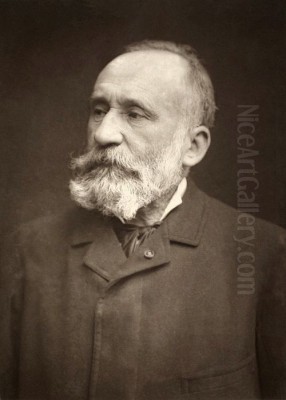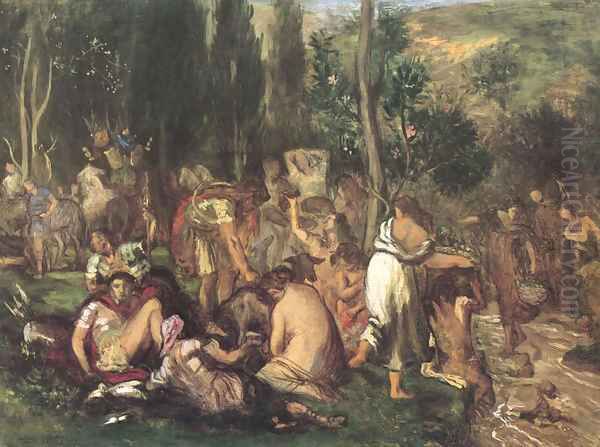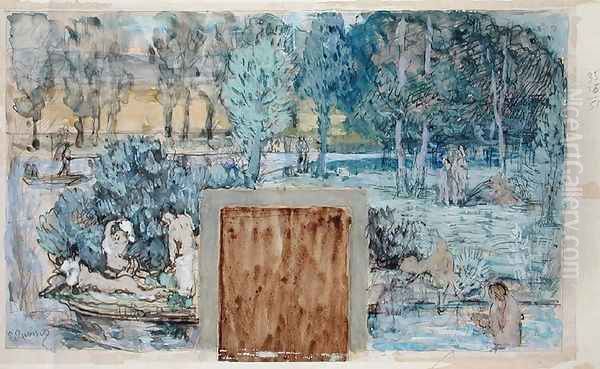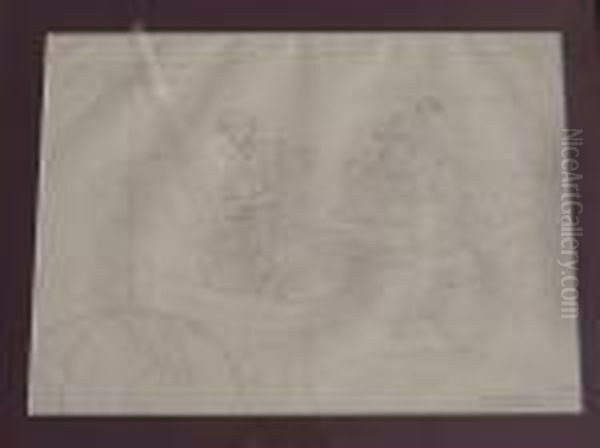
Pierre-Cécile Puvis de Chavannes stands as a pivotal figure in nineteenth-century French art. Born on December 14, 1824, and passing away on October 24, 1898, his life spanned a period of significant artistic transformation in France. He is renowned primarily as a painter of monumental murals and as a leading proponent of the Symbolist movement, creating works that bridged the gap between academic tradition and emerging modernism. His unique style, characterized by simplified forms, muted colors, and idealized themes, left an indelible mark on the art world and influenced generations of artists who followed.
Early Life and Artistic Awakening
Puvis de Chavannes was born just outside Lyon, France, into a family with roots in the old Burgundian nobility. His father was a respected mining engineer, and his mother hailed from aristocratic lineage in Poitiers. Despite his Lyon origins, Puvis often preferred to emphasize his Burgundian heritage throughout his life. Initially, his path seemed set towards following his father's profession, and he pursued studies in engineering.
However, fate intervened in the form of a serious illness, which forced him to abandon his engineering studies. During his convalescence, he embarked on a recuperative journey to Italy. This trip proved to be transformative. Immersed in the masterpieces of Italian art, particularly the frescoes of the early Renaissance masters like Giotto and the enduring legacy of Greco-Roman antiquity, Puvis experienced an artistic epiphany. He later reportedly remarked on this shift, suggesting he hadn't considered painting seriously until witnessing Italy's artistic heritage. This journey solidified his decision to dedicate his life to art.
Formative Years and Influences
Upon returning to France, Puvis de Chavannes committed himself to artistic training. He initially studied briefly in the studio of the great Romantic painter Eugène Delacroix, though this period was cut short, possibly due to health reasons or stylistic divergence. He then spent time, between 1846 and 1847, learning under Henri Scheffer, a respected painter, until Scheffer closed his studio due to his own health issues.

Following this, Puvis continued his studies with Thomas Couture, another prominent academic painter known for his historical subjects and rigorous technique. Couture's studio was a training ground for many artists, including Édouard Manet. However, Puvis found Couture's approach ultimately unsatisfying as well. Alongside these formal studies, his trips to Italy remained a profound source of inspiration. The clarity, order, and monumental calm of artists like Giotto and Piero della Francesca, as well as the influence of classical sculpture, deeply resonated with him and steered his developing aesthetic away from the high drama of Romanticism. Some accounts also suggest the influence of Théodore Chassériau, whose own work blended classical lines with romantic feeling.
Development of a Unique Style
Puvis de Chavannes gradually forged a highly personal and distinctive artistic style. Moving away from the dominant trends of Realism and the burgeoning Impressionist movement, he cultivated an approach rooted in simplification, harmony, and intellectual depth. His work is characterized by its emphasis on flattened forms and a shallow pictorial space, often reminiscent of frescoes. He favored clear, strong compositional structures and a sense of rhythmic order.
His color palette was notably subdued, often employing pale, chalky tones – blues, grays, ochres, and whites – which contributed to the serene, dreamlike quality of his paintings and murals. This deliberate limitation of color aimed to enhance the decorative and architectural function of his large-scale works, allowing them to harmonize with their surroundings rather than overwhelm them. His drawing style emphasized elegant, simplified outlines and idealized human figures, often depicted in static, contemplative poses. This combination of elements created an art that was both monumental and restrained, conveying universal themes through allegorical or symbolic means. His style is strongly associated with Symbolism, focusing on ideas, emotions, and idealized states rather than literal depiction.
The Muralist of the Republic
While Puvis de Chavannes also produced significant easel paintings, his reputation rests largely on his monumental mural cycles commissioned for major public buildings in France and abroad. In the latter half of the 19th century, under the Third Republic, there was a renewed interest in large-scale decorative painting to adorn civic institutions, celebrating French history, culture, and ideals. Puvis became the preeminent muralist of his time.
His first major mural commissions were for the Musée de Picardie in Amiens, including the allegorical works Concordia (Peace) and Bellum (War), completed in 1861. These established his capacity for grand-scale composition and allegorical invention. Perhaps his most famous cycle is the series depicting the life of Saint Genevieve, the patron saint of Paris, created between 1876 and 1878 and later expanded, for the Panthéon in Paris. These serene panels, such as The Pastoral Life of Saint Genevieve, exemplify his mature style with their calm dignity and harmonious integration with the architecture.

Other significant mural projects followed, including decorations for the Palais des Beaux-Arts in his native Lyon, the Sorbonne University in Paris, and the Hôtel de Ville (City Hall) in Paris, for which he painted Summer (1891) and other allegorical panels representing the seasons and civic virtues. His fame extended internationally, leading to a major commission for the Boston Public Library in the United States, where he created a cycle depicting The Muses Welcoming the Genius of Enlightenment (completed 1896), further cementing his status as a master of monumental decoration.
Key Easel Paintings
Beyond his murals, Puvis de Chavannes created numerous important easel paintings that explored similar themes and stylistic concerns on a more intimate scale. These works often served as studies or independent explorations of the ideas that animated his larger projects. They allowed for a different kind of focus, though they retained the characteristic simplification and symbolic resonance of his murals.
Le Pauvre Pêcheur (The Poor Fisherman), painted in 1881 and now housed in the Musée d'Orsay, is one of his most celebrated easel works. It depicts a gaunt fisherman in a desolate landscape, conveying a sense of quiet resignation and melancholy. The painting's stark composition and muted colors were influential, admired by artists like Georges Seurat.
Another significant work is Le Rêve (The Dream) from 1883. This painting portrays figures sleeping under the moonlight, suggesting themes of escape, introspection, and the subconscious. It blends classical allusions with a distinctly Symbolist atmosphere, exploring the inner world rather than external reality. Hope (versions exist, notably one from c. 1872) depicts a young, fragile figure seated in a desolate landscape, holding a green sprig, symbolizing resilience and optimism amidst adversity. These works, along with others like Young Girls by the Seaside, demonstrate his ability to convey profound emotional and intellectual states through simplified means and evocative imagery.
Personal Life and Relationships
Puvis de Chavannes's personal life contained complexities that paralleled his dedicated artistic career. His early life was marked by the loss of his parents, an experience that undoubtedly shaped his character. He maintained a long and devoted relationship with the Romanian princess Marie Cantacuzène. Their companionship began around 1856 and lasted for over four decades. Despite their long intimacy, they only formally married in 1898, shortly before their deaths. Marie provided crucial emotional support and stability, particularly in his later years.

Earlier in his life, during his time in Montmartre, Puvis had a relationship with a young model named Suzanne Valadon. Valadon, who modeled for Puvis as well as for artists like Pierre-Auguste Renoir and Edgar Degas, later became a significant painter in her own right. She was also the mother of the painter Maurice Utrillo. While the relationship with Valadon was part of his younger bohemian life, his enduring partnership with Marie Cantacuzène defined his mature personal life.
Leadership and the Société Nationale des Beaux-Arts
Puvis de Chavannes played an important role not only as an artist but also as a leader within the Parisian art world. In 1890, he became a co-founder and the first president of the Société Nationale des Beaux-Arts (SNBA). This organization was established as a more liberal alternative to the official Salon, which had become increasingly resistant to new artistic trends.
The SNBA provided a crucial exhibition venue for artists who felt excluded by the traditional Salon system. Under Puvis's leadership, the society championed a diversity of styles, although it became particularly associated with Symbolist and more decorative tendencies. His presidency lent considerable prestige to the new society, and he used his position to support and encourage younger artists, including figures like Robert Genin. His involvement demonstrated his commitment to fostering a supportive environment for artistic creation beyond the confines of the established academic structures. His friends and associates included prominent literary figures like Charles Baudelaire and Théophile Gautier, who shared interests in symbolism and aesthetics.
Influence and Legacy
Pierre Puvis de Chavannes occupies a unique and influential position in the history of late 19th-century art. He was respected by traditionalists for his classical draftsmanship and monumental compositions, yet his innovative approach to form, color, and subject matter made him a crucial figure for avant-garde artists seeking alternatives to both academicism and Impressionism. His work served as a vital link between older traditions and the emerging currents of modern art.
His impact on Symbolism was profound. His emphasis on suggestion over description, mood over narrative detail, and the decorative potential of painting resonated deeply with Symbolist painters like Paul Gauguin, Maurice Denis, and Émile Bernard. Gauguin, in particular, admired Puvis's simplified forms and flat color planes. Georges Seurat, the pioneer of Neo-Impressionism, also drew inspiration from the compositional clarity and serene mood of Puvis's work, particularly evident when comparing The Poor Fisherman to Seurat's own figures.

The influence extended into the 20th century. A young Pablo Picasso greatly admired Puvis during his Blue Period, echoing the French master's melancholic figures and muted palette. Henri Matisse also acknowledged Puvis's importance, particularly his use of color for expressive and decorative purposes. Other artists, including the sculptor Aristide Maillol and even painters like Renoir and Paul Cézanne, are sometimes cited as having engaged with aspects of his style, particularly his sense of structure and simplified form, though the direct influence varies. Puvis's legacy lies in his demonstration that painting could be both monumental and modern, decorative and deeply meaningful.
Recognition and Honors
While Puvis de Chavannes's success was built primarily on the strength of his commissions and the respect he commanded within the art world, he did receive official recognition. He was awarded the prestigious Légion d'honneur, France's highest order of merit. Sources suggest he was made a Chevalier (Knight) perhaps as early as 1867, rising through the ranks to Commander by 1889, acknowledging his significant contributions to French art and culture.
However, unlike some contemporaries who actively sought prizes at the official Salon, Puvis's reputation was less dependent on competitive awards. His status derived from the consistent demand for his murals in prominent public spaces, the critical acclaim (and sometimes controversy) his work generated, and his leadership role in organizations like the SNBA. His influence was perhaps his greatest honor, shaping the direction of art in France and beyond.
Final Years and Enduring Presence
Puvis de Chavannes remained active late into his life, completing the Boston Public Library murals in his seventies. His final years were shadowed by the death of his wife, Marie Cantacuzène, in August 1898. Deeply affected by her loss after their decades-long companionship, Puvis himself passed away just two months later, on October 24, 1898, in Paris. His death marked the end of a significant era in French painting.
Today, Puvis de Chavannes's works are held in major museums and collections worldwide. His easel paintings can be found in institutions such as the Musée d'Orsay and the Louvre in Paris, the Metropolitan Museum of Art in New York, the National Gallery of Art in Washington D.C., the Art Institute of Chicago, the Philadelphia Museum of Art, the Norton Simon Museum, the Hermitage Museum in St. Petersburg, and the Kunstmuseum Basel, among others. His monumental murals continue to adorn the walls of the Panthéon, the Hôtel de Ville, the Sorbonne in Paris, the museums of Amiens and Lyon, and the Boston Public Library, ensuring his unique artistic vision remains accessible to the public. He remains a testament to the power of serene classicism infused with symbolic depth, a painter whose quiet art continues to resonate.